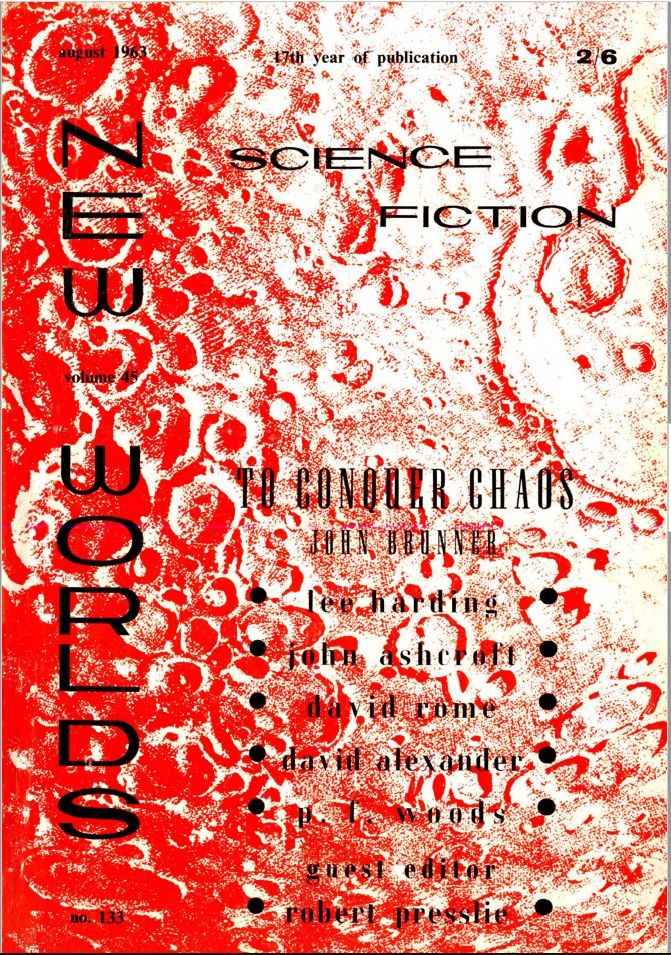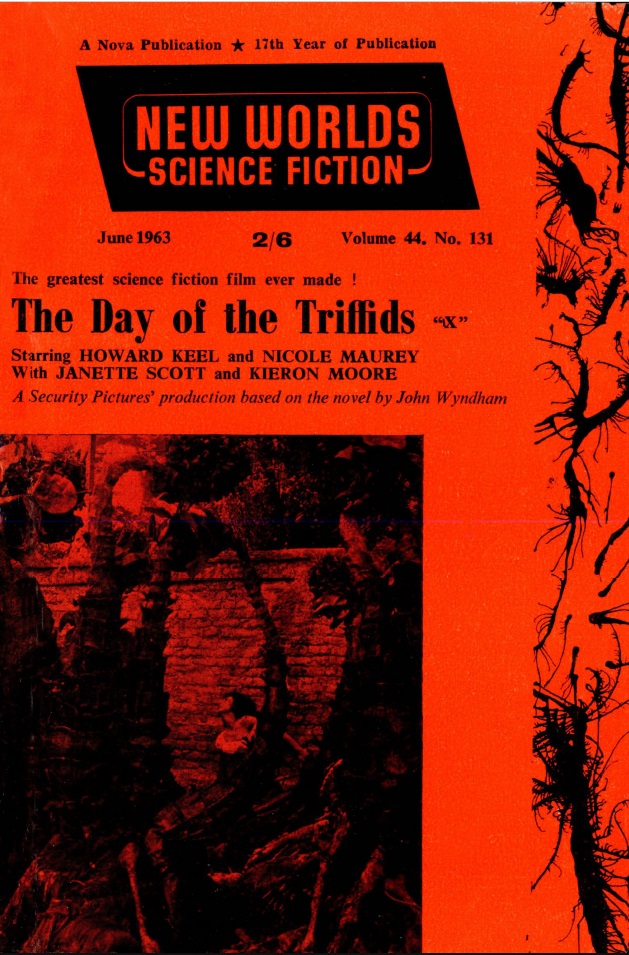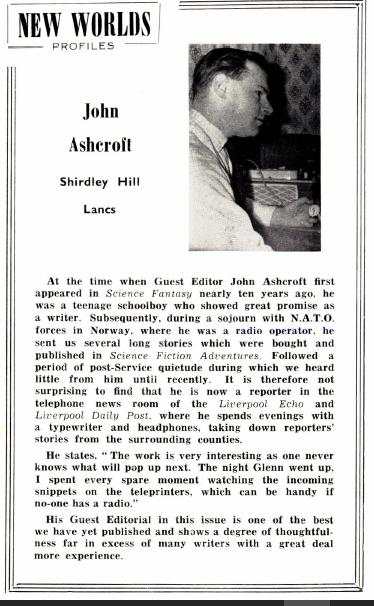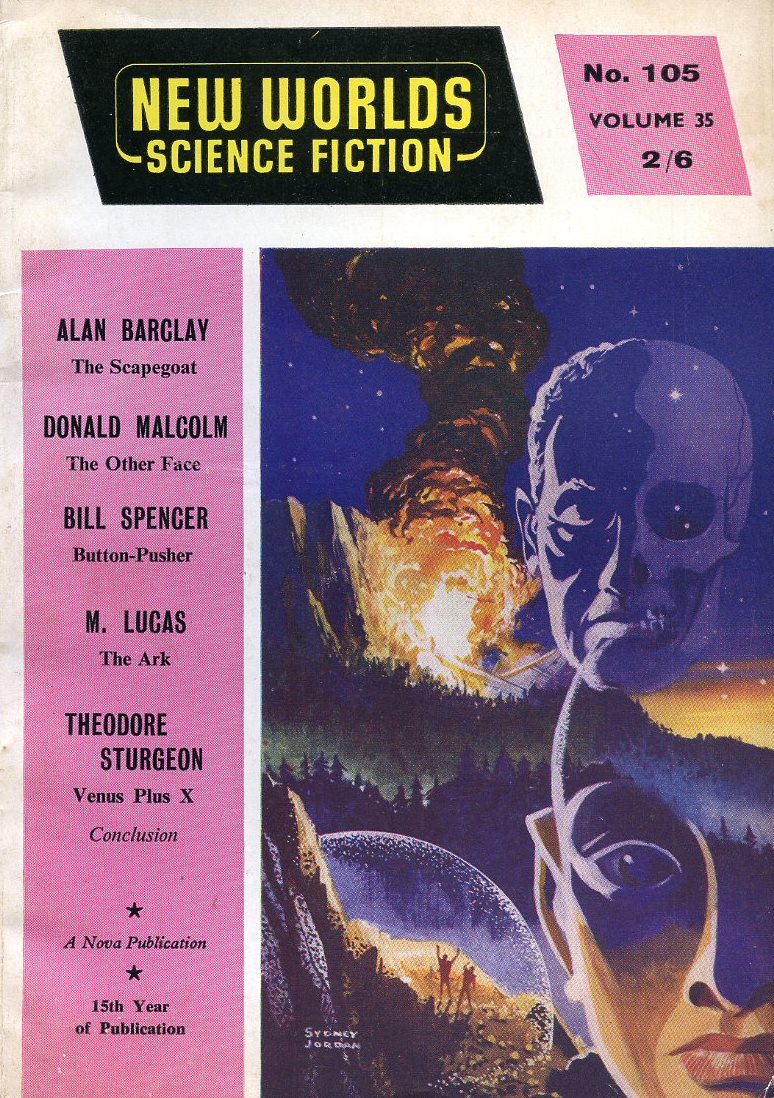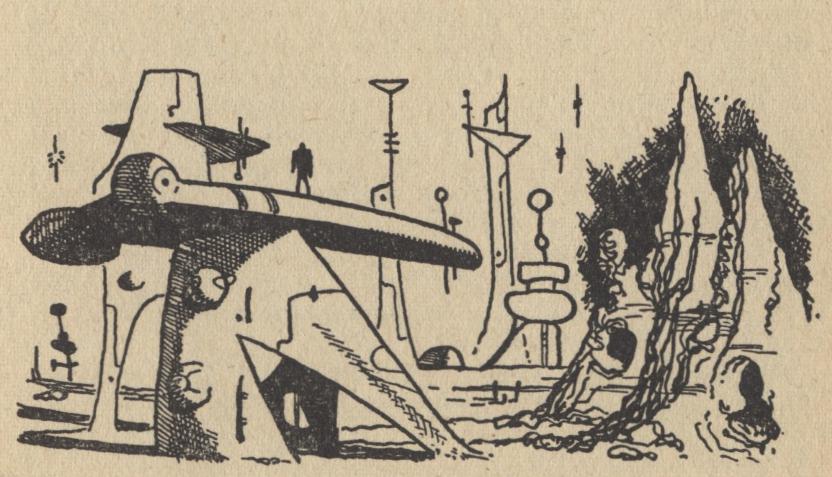
by Mark Yon
Scenes from England
Hello again!
As I briefly mentioned last time, much of this month has been about the country dealing with the death and subsequent state funeral of Sir Winston Churchill. It has felt like the passing of an era – the old guard, admittedly, but an end, nevertheless. It seems to have cast a cloud over everything.
I turned to the two magazines to try and cheer me up.
The First Issue At Hand
So: which magazine arrived first? The winner was (again)… Science Fantasy.
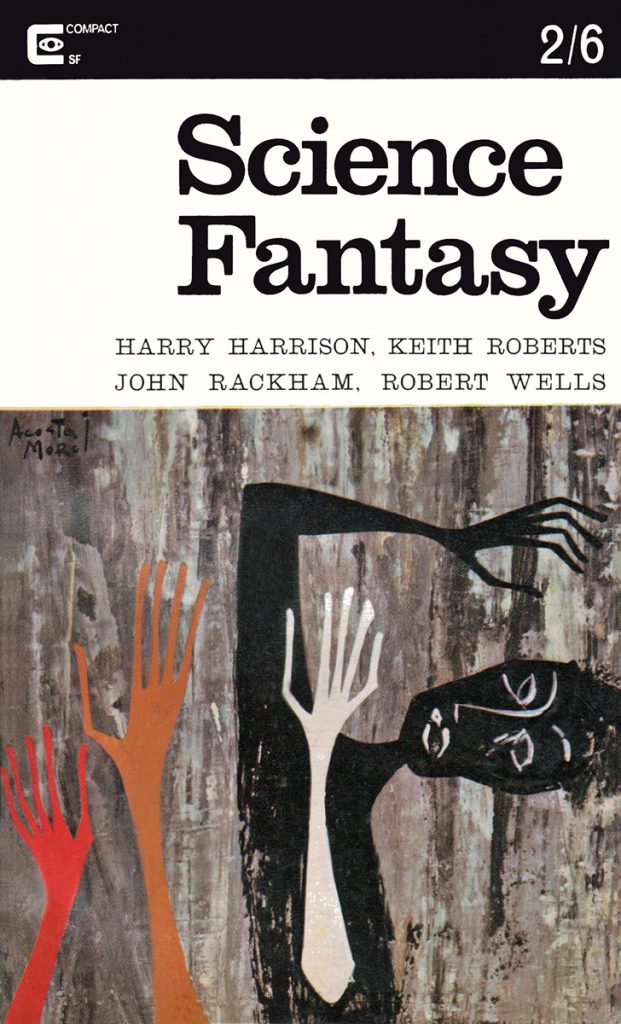
[Impressive cover this month. Remember the bad old days covers of the Carnell New Worlds era?]
Looking beyond the arty cover by Agosta Morol, I see that the magazine, like New Worlds, now has an Associate Editor. In this case its J. Parkhill-Rathbone (no first name given.) This is, no doubt, to cope with the extra volume created by the magazine going monthly.
Not that that is shown particularly by the Editorial, which even admits that there’s little to say this month and then fills the space by mentioning up-coming works of interest. There’s also an intriguing glimpse into the life of an editor, which involves Kyril, Jim Ballard, Brian Aldiss and some Liebfraumilch.
To the stories themselves.
The Outcast, by Harry Harrison
We start with a big name, the usually wonderful Harry Harrison. He has been here before but in his many guises as short story author, editor and collaborator. It is great to read a longer story. This is one of those “spaceships as cruise liner” type of tales, with a notorious passenger causing unrest amongst the passengers. I guess that it must be akin to being on a holiday with someone like Josef Mengele!
It’s told with the usual Harrison skill, with the occasional plot-point to keep the reader guessing. The protagonist is given a surprisingly nuanced character and is not the monster some would suggest, and by the end the story becomes one of redemption. Solidly thought-provoking, if unremarkable. It’s a good start to the issue. 3 out of 5.
Song of the Syren, by Robert Wells
A story about singing alien plants and the development of bad worker relationships, but also about the trouble women cause in space when surrounded by men. As bad as it sounds, this attempts to tell a mystery plot with misogynistic clichés that I thought went out with the pulps of the 1940’s. For example, “She was a sixth year student, one of the brightest in the unit’s botanical section, but it was an open secret that she would resign when her seven years tour of duty was complete and opt for a mating and reproductive role back in Solar.” Not one of the magazine’s brightest moments. 2 out of 5.
Moriarty, by Philip Wordley
A crime story about the protagonist’s relationship with a female telepathic cop in L.A. The twist here is that the policewoman wants the burglar to hold off from robbing a bank so that she can get a bigger catch, a big-time mobster planning to rob the same bank in a few days’ time. Another predictable story that doesn’t upset things too much. 2 out of 5.
Bring Back A Life, by John Rackham
Peter Raynor is a biochemist who finds himself abducted by a group of VIPs for a secret mission – the Prime Minister has been struck down with Ringer’s Parethis – a brain disease which has only been cured before by accident – before a major political conference in three weeks’ time. Raynor is asked to try and come up with a cure for the PM. The solution appears to be one in the past, so Raynor travels to get it. An adventure story, admittedly fast-paced, that seems rather contrived when you stop to think about it. 2 out of 5.
 [Image by the writer]
[Image by the writer]
The Jennifer, by Keith Roberts
What? Another month, another Keith Roberts story? This is the latest from a magazine favourite, an Anita story that was delayed from last month’s issue. If you like the continuing stories of this young teenage witch, described as “shameless” in the banner, I can’t see why you wouldn’t like this one – even with the still-present annoying Granny. This time Anita and Granny Thompson are on holiday at the seaside when Anita meets a mermaid, much to Granny’s disgust. Anita catches a Serpent ride into the sea… and then the story abruptly stops, as if the writer had run out of time and space. I would have liked more, which is the sign of a good story, although I’m going to dock a point for its abrupt end, which makes it feel like more of a story extract than a story. However, like most of these Anita stories, The Jennifer is light and fun, even if Granny still irks me. 3 out of 5.
A Cave in the Hills, by R. W. Mackelworth
Here’s an author you may recognise from the Carnell New Worlds days. He was last seen in the February 1964 issue of New Worlds with The Unexpected Martyr. This is the story of a bored housewife who in a utopian future finds that her boring husband has ended up in debt and in Debtors prison. Her own future is uncertain, dependent on a visit from the Adjudicator. But bigger issues are at play. This is another story of the value of identity and being different from the majority, themes that Mackelworth has examined before, but manages pretty well. 3 out of 5.
Hunt a Wild Dream, by D. R. Heywood
Another new writer. Do you remember recently when editor Kyril Bonfiglioni said that he was a fan of “time-travel safari” stories? Well, this one starts with a safari, at least.
Our hero of the piece is Manfred ‘Mac’ Cullen, known for “bringing them back alive” (which wins points from me, though I’m not entirely sure whether that statement means animals or tourists!) We follow Cullen as he starts a journey into the African grasslands, which suggests that he’s a more complex character than my stereotype might suggest. However, this one just starts to get interesting and then stops. There’s some ruminations on the spiritual beliefs of the local Nandi tribe, that Cullen knows and understands, but as soon as we hear of some murders that may have happened on lands where the locals refuse to go, the story stops, to be continued next month.
Based on what I’ve read here, this could develop into an interesting and scary story or fizzle to nothing. The jury is out, but based on what I’ve read here I’ll give Hunt A Wild Dream a cautious 3 out of 5 so far.
Summing up Science Fantasy
Although this issue of Science Fantasy is more up-beat than the last, I am a little underwhelmed by it. There’s nothing badly wrong – OK, there’s one story that’s really not good – but it’s a solid issue. And that may be the problem. Most of it is entertaining, but there’s nothing here to really grab my attention like the Burnett Swann serial did in previous months. I’m pretty sure that this is another issue that was worth me buying, yet I’ll have forgotten about by the end of the year. The best stories for me are the Harrison, and even that is not the best of his I’ve read, and the Anita story, which has its issues.
So let’s go to my second issue.
The Second Issue At Hand
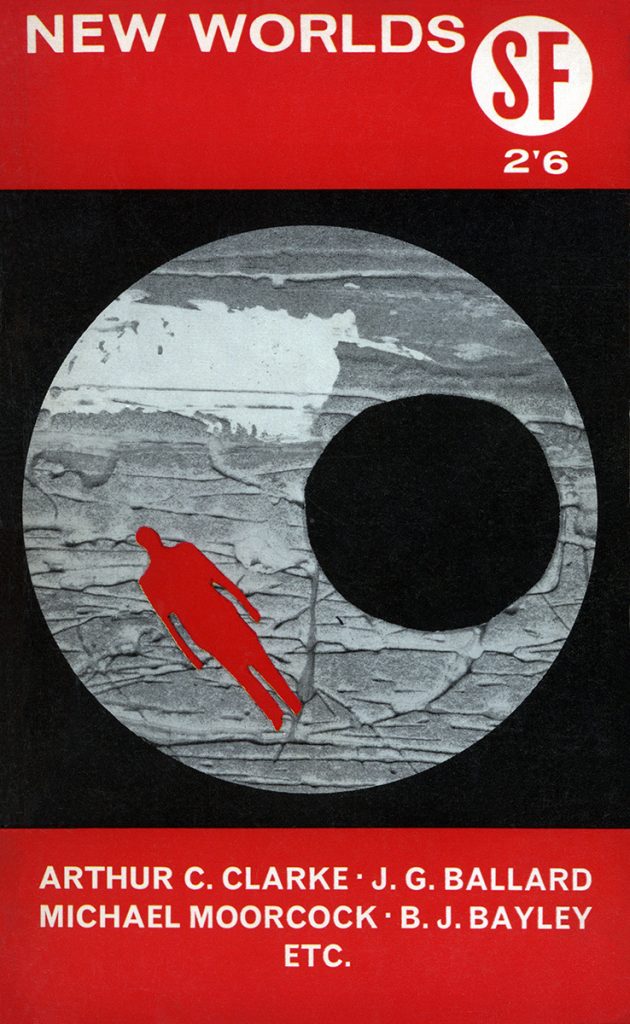
As the cover heralds, this month’s New Worlds has a couple of well-known authors: J G Ballard and Arthur C Clarke.
This month’s Editorial, I’m pleased to say, is back to the discussion format that we seemed to have lost last month. It’s another call to arms, a rumination that science fiction is moving away from the traditional space exploration story to ones set on Earth and are more involved with inner space – the mind and its “capacities and defects”. It’s an interesting point, and I guess one which makes the British SF increasingly different to the majority of stories I see in the American magazines. It ends with the point that new young writers must look forward and not back as the values of the Sixties are not those of the 1950’s.

[Art by aTom]
All the King’s Men, by B J Bailey
A stand-alone novelette from Barrington J (BJ) Bailey this month. And I liked it very much, up to the end.
In 2034 the Earth has been invaded and peacefully vanquished by aliens, who whilst keeping control over the locals fight against each other over the Earth territories. The story is told by Smith, the human second in command who with Holath Horan Sorn has kept Britain generally peaceful for the alien King of All Britain, although, unsurprisingly, Sorn and our narrator are seen as traitors by many of the native populace.
The story begins with the fact that Sorn has died and there is an impending power struggle to take his place. Smith is bullied by Hotch to take the human’s side and use the disruption to cause chaos for the King, who has relied heavily on the advice of his human advisors to maintain order. It has in the past made decisions that are mistakes that the humans have had to nullify.
At the same time the King is concerned with a war between himself as King of Britain and other aliens who have taken over Brazil. Much of the story is how Smith tries to fulfil the role of Sorn as intermediary between the alien King, who is aware that his thinking is very different to that of Humans, and at the same time Smith struggles to represent the British people, who are constantly fretting under the control of an alien leader.
So why did I really like this one? The setup is intriguing. It’s an engaging mixture of historical ideas (kingdoms, courts, feuding Kings) in a future setting (spaceships, alien art, electric trains), with a character-based tone that I really engaged with. I was going to give this one 4 stars, until I got to the ending, where the author abruptly gives everything up and the lead character basically says “I don’t know what happened.” 3 out of 5.
Sunjammer, by Arthur C Clarke
I really like Arthur’s clarity of prose and this one doesn’t disappoint, although my enthusiasm is tempered by the fact that it is a reprint of a story first published in the USA as a juvenile story in Boy’s Life in March 1964. Sunjammer is the story of a race around the Solar System using spacecraft that use solar winds for propulsion. I really liked it as a good old-fashioned ‘sense of wonder’ story that Clarke is so good at – but it also shows us what was mentioned in the Editorial, that British SF has changed a lot recently and this one is definitely old school. Like I said last month about another old-style story, Sunjammer’s exciting and I enjoyed it a lot, but it is nothing that would be out of place from the magazines of the 1950’s, and it has been printed before. 3 out of 5.
First Dawn, by Donald Malcolm
Here’s the return of an author from the Carnell Era. Donald Malcolm was last seen in the April 1964 issue of New Worlds, the last issue edited by Carnell. I thought that beyond the reach of storms was OK, if nothing special. I liked this one more, though it is a minor piece describing dawn on an ice planet as seen from the perspective of a mole-like alien. It’s nicely done but like Malcolm's last effort nothing to remember for too long. 2 out of 5.

Dune Limbo, by J G Ballard
To say that this story is much-anticipated is an understatement. If you didn’t know already, JG is making an impact not just here in Britain but also overseas with his strange fiction. He is an author that always makes me think and pushes literary boundaries at the same time. I never know what a story of his is going to say, or indeed how it is going to say it!
Dune Limbo is a little bit of a cheat however, as it is an extract from a bigger work. The Drought (also known as The Burning World to you in the US) is due out as a novel later in the year (hurrah!) and Dune Limbo is from the middle part. This is a little disappointing – how do you feel about starting a novel in the middle? – but there is a lengthy summary of what has gone before at the start.
It is obvious early on that Dune Limbo does have some of the usual Ballard-ian themes though. It is basically about a world in decline, where a global drought has changed the world we know. To this Ballard brings his usual types of characters – strange and often unpleasant. This middle part shows us a story of this new harsh environment, with humans hanging on to existence in a world different to our own.
This sounds like the Ballard of The Drowned World and Equinox. But…. dare I say it, Dune Limbo is slightly more straight-forward, perhaps even less challenging than some of Ballard’s other recent work I’ve read. It feels like there’s elements here I’ve read before. That’s not necessarily a bad thing, but it means that for me it doesn’t quite have the impact that, say, The Terminal Beach had. Don’t get me wrong – there’s some lovely images created by the prose, for example – but it may not create as much of a stir as some of his earlier work. I liked it, though.
Perhaps it may introduce the author to some new readers previously unfamiliar with Ballard’s work, but I felt a little short-changed as it felt more like an advertisement for his upcoming novel than an actual story. Nevertheless, Ballard’s prose is still seductive, and so for all my grumbles it is still 4 out of 5.
Escape from Evening, by Michael Moorcock
And here’s another story by the Editor. This time it is a novelette from the ongoing series that riffs heavily on the later stages of H G Wells’ The Time Machine. (Well, if you’re going to borrow, why not borrow from the best?)
Escape from Evening is set in a distant future, where a Moonite decides to go and live on the Earth. Despite the Earth people feeling that he would find their decaying society boring, Pepin Hunchback revels in the fact that Earth is real and not artificial like the Moon and decides to explore his new home. His travels lead him to Lanjis Liho, where we pick up points and meet characters we have heard of before back in the story The Time Dweller in the February 1964 issue of New Worlds. Lanjis Liho is the home of the fabled Chrononauts who (as we found out in the last Chrononaut story) can travel through time at will. Pepin attempts to travel back in time to a place where he would feel more in tune with their world, but there are revelations it would be wrong for me to reveal here.
There are parts of this story I liked, and it is quite different to Moorcock’s last outing – though the use of a character named ‘Pepin Hunchback’ and a ‘Hooknosed Wanderer’ may be borrowing from the classics a little too much for comfort. 3 out of 5.
The Uncivil War, by R J Tilley
Another war story in this issue, of a sort. RJ Tilley’s tale is an attempt to lighten the mood a little as we read of a young reporter’s first visit to the notorious Firkl’s Bar. Whilst there he is regaled with a shaggy-dog story about an old space-dog’s secret mission where miscommunication and bad assumptions almost start a war. Tired and overlong. 2 out of 5.
Articles
Mixed throughout the issue this month. There’s a review by Alan Dodd of the film Voyage to the End of the Universe (isn’t current thinking that there is no end?) and a summary of the latest amateur magazines.
In terms of Books this month, there is only one book reviewed, but as has been the trend of late, the review is in detail. Assistant Editor Langdon Jones has a quote for a title guaranteed to grab your attention – "That Is Not Oil, Madam. That Is Jellied Consomme", a quote from the Introduction of The Weird Ones, a collection introduced by H L Gold, who you may also know as the Editor of Galaxy magazine.
The book surprises with its unusual introduction (and is where the titular quote comes from) but is quite frugal otherwise. Frederik Pohl’s Small Lords starts well but soon becomes no more than ‘readable’, Poul Anderson’s Sentiment Inc. the same, whilst Milton Lesser’s Name Your Tiger is the most readable and perhaps predictably Eando Binder’s dated Iron Man the worst. There’s some wincingly awful quotes to make that point too.
The Letters Pages are a pleasing mixture of praise and complaint. Moans about Ron Goulart’s review of Aldiss’ Greybeard, praise for the move to monthly and monstrous book reviews – and still more argument about Langdon Jones’ story I Remember, Anita (reviewed back in issue 144).

Ratings this month for issue 146 (January 1965). Very pleased with this one. Well done to David Rome, one of the more accessible New Wave stories of late – and we have a tie!
Summing up New Worlds
Another strong issue this month, perhaps the one I have consistently enjoyed most in a long time. There’s the usual eclectic mixture – it is mentioned as such in the Editorial – but it was one of the rare issues where I loved pretty much everything, even the stuff I would normally say I didn’t. No religious preaching, no apocalyptic Armageddons, for a change.
Summing up overall
Whilst Science Fantasy has its moments, the New Worlds issue is a clear winner.
And that’s it for this time. Until the next…
[Come join us at Portal 55, Galactic Journey's real-time lounge! Talk about your favorite SFF, chat with the Traveler and co., relax, sit a spell…]



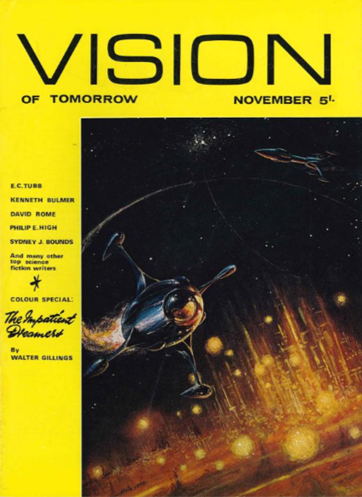






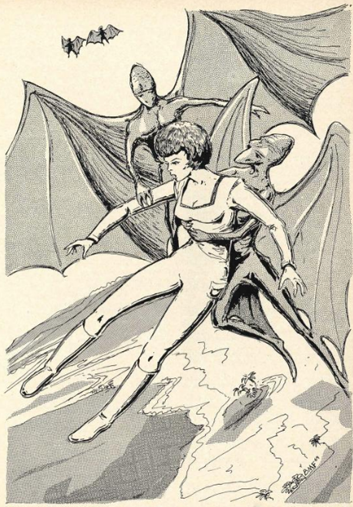



![[October 6, 1969] The Rule of a Mediocracy (<i>Vision of Tomorrow #3</i>)](https://galacticjourney.org/wp-content/uploads/2024/10/Vision-2-362x372.png)


![[March 4, 1968] Everything Old is New Again (<i>New Writings in SF-12</i> & <i>Famous Science Fiction</i> Issues #4-6)](https://galacticjourney.org/wp-content/uploads/2023/02/Cover-396x372.png)



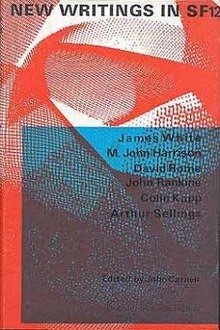
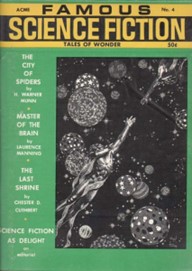
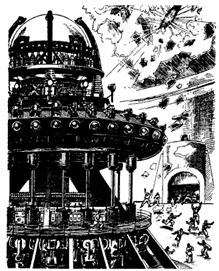
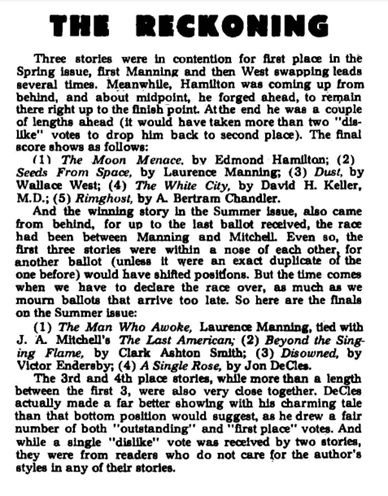
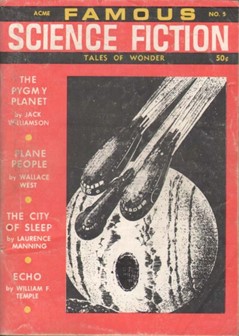
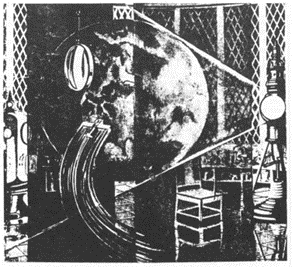


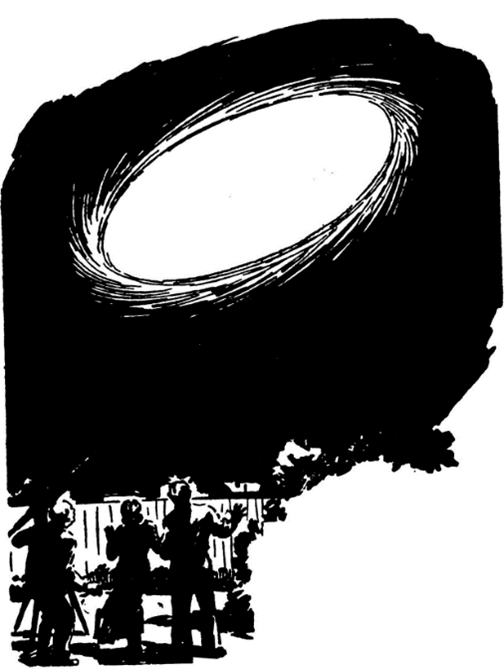
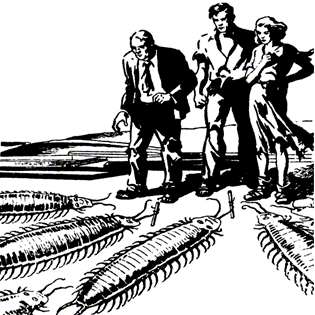

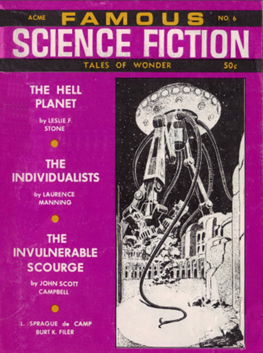

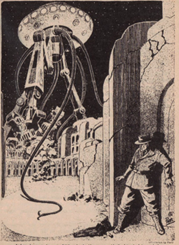
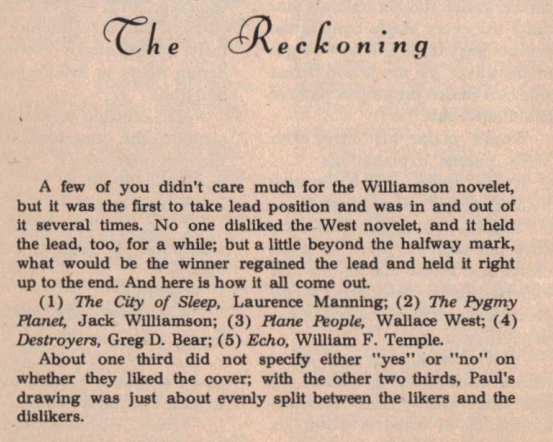

![[February 24, 1965] Doctors, Hunchbacks and Dunes … <i>New Worlds</i> and <i>Science Fantasy</i>, February/March 1965](https://galacticjourney.org/wp-content/uploads/2020/02/Science-Fantasy-March-1965-672x372.jpg)


 [Image by the writer]
[Image by the writer]



![[December 29, 1964] Be Ye All of Good Cheer… <i>New Worlds, January 1965</i>](https://galacticjourney.org/wp-content/uploads/2019/12/New-Worlds-Jan-65-522x372.png)
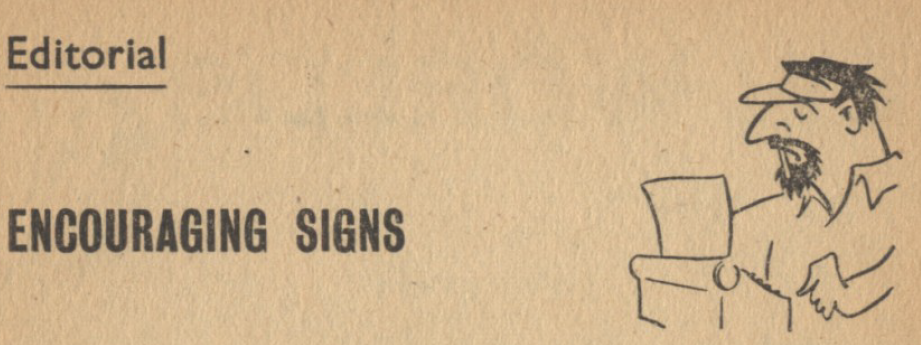

 cover by Robert J. Tilley
cover by Robert J. Tilley



![[November 22, 1963 cont.] Ripples down under](https://galacticjourney.org/wp-content/uploads/2018/11/631122dead-672x372.jpg)


